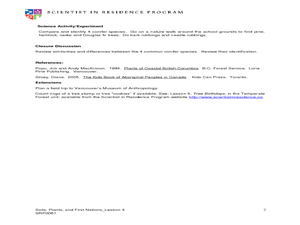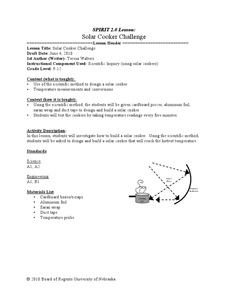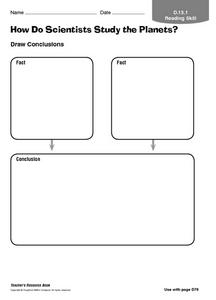Curated OER
Western Red Cedar
Students explore the First Nations uses of the Western Cedar tree. In this nature lesson students compare and identify four conifer species. The students go on a nature walk.
Curated OER
Solar Cooker Challenge
Students use the scientific method to design a slow cooker. In this experimental method lesson students measure temperatures and conversions of the solar cooker that they create.
Curated OER
What's Bugging You?
Second graders investigate insects. In this parts of a whole, 2nd graders discuss what the three body parts of an insect are as well as the antenna. Students create their own insect labeling each body part and antenna.
Curated OER
What Do Animals Eat?
In this animal diet worksheet, students will brainstorm what animals eat and write it down in a graphic organizer. Then students will brainstorm what people should eat and write it down.
Curated OER
How Do Scientists Study the Planets?
In this planets worksheet, students brainstorm 2 facts about how scientists study the planets. Then students will come to a conclusion based on their facts. This worksheet is a graphic organizer.
Curated OER
Uses of Natural Resources
In this natural resource worksheet, students will brainstorm examples of how natural resources are used. Students will fill in three questions concerning air, soil, and water.
Curated OER
Uses for Natural Resources
In this natural resources worksheet, students will brainstorm different uses for air and water resources. Students will fill in four answers in a graphic organizer.
Curated OER
What Changes Do Moving Plates Cause?
In this plate tectonic worksheets, student will brainstorm three things that cause the earth's plates to move and then they will conclude with the effect of these movements.
Curated OER
How Do Scientists Use Telescopes?
In this astronomy worksheet, students will brainstorm problems that scientists might face when studying objects that are far away and then students will come up with a solution for that problem.
Curated OER
How Do Living Things Compete?
In this living things worksheet, students will brainstorm and fill in a graphic organizer focusing on the main idea of how living things compete. Then students will add four details to support their main idea.
Curated OER
Traits of Living Things
In this characteristics of living things worksheet, students will brainstorm five traits of living things and fill in a graphic organizer.
Curated OER
How Do Adaptations Help Living Things?
In this adaptations worksheet, students will brainstorm a problem that a living thing might face in its environment. Then students will write down what solution or adaptation that living thing has that allows it to survive that...
Curated OER
What Forces Come From Magnets?
In this magnet characteristics worksheet, students will brainstorm what forces come from magnets and three supporting facts for that force.
Curated OER
How Does Thermal Energy Spread?
In this thermal energy worksheet, students will brainstorm a main idea on how thermal energy is spread and then they will write in three details that support their main idea.
Curated OER
How Do Nitrogen and Water Cycle?
In this nitrogen and water cycle worksheet, students will brainstorm a main idea about the nitrogen cycle or the water cycle. Then the student will write in three details that support their main idea.
Curated OER
Making Things Move
In this movement of things worksheet, students will brainstorm the effect of pushing or pulling on an object. Students will write down their answers in a graphic organizer.
Curated OER
How Does Sound Behave?
In this sound worksheet, students will brainstorm the cause and effect of sound and how sound behaves in different situations. Students will complete a graphic organizer.
Curated OER
What Can Change an Object's Motion?
In this object in motion worksheet, students will brainstorm ideas of what can change an object's motion. Then the student will write in supporting details for each idea in a graphic organizer.
Curated OER
What is Physical Change?
In this physical change worksheet, students will brainstorm types of physical change and will write down the cause and effect of each example in this graphic organizer.
Curated OER
What Are Types of Chemical Reactions?
In this chemical reactions worksheet, students will brainstorm different types of chemical reactions and then write a brief description of each one.
Curated OER
How is Genetic Information Transferred?
In this genetics worksheet, students will brainstorm and write down as many causes and effects relating to the transfer of genetic information.
Curated OER
What Things Move Fast and Slow?
In this fast and slow movement worksheet, students will brainstorm things that move at fast speeds and things that move at slow speeds. Students will write these items in the correct category in this graphic organizer worksheet.
Curated OER
Matter
In this matter worksheet, students will brainstorm two examples of a pure substance and two examples of a mixture and write these into a graphic organizer.
Curated OER
What is Air?
In this air worksheet, students will brainstorm 3 things that make up the air around them. Students will write down their ideas in a graphic organizer.

























